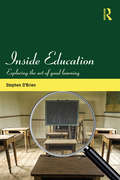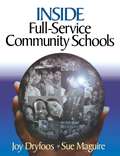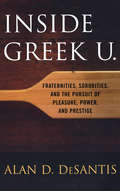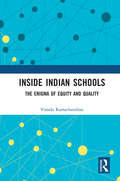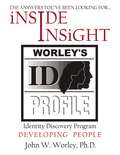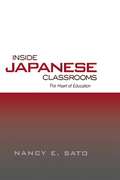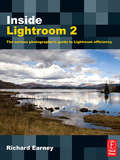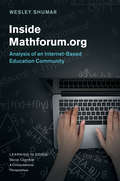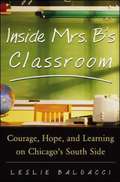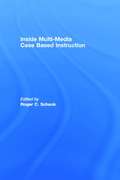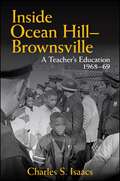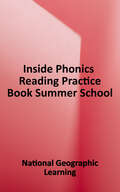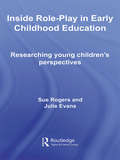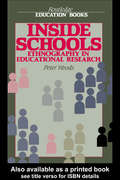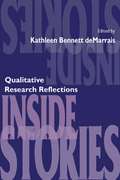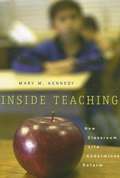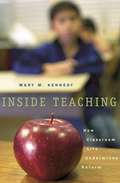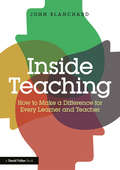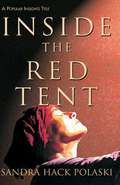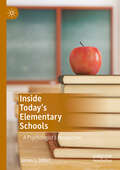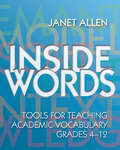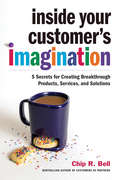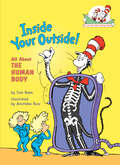- Table View
- List View
Inside Education: Exploring the art of good learning
by Stephen O'BrienTo learn more about learning – what it is and how it works – it is necessary to look inside education. Inside Education takes the reader on a journey of four ‘live’ education projects: the first all-Irish speaking, mixed-gendered, multi-faith primary school in the Republic of Ireland ideally suited to exploring learning identity; an alternative post-primary school for those who leave (or are left behind by) the formal education system also based in the Republic of Ireland and ideally suited to exploring personal learning; an early college school that enables students to simultaneously sit their high-school diploma and college exams based in Queens, New York and ideally suited to exploring learning success; and an adult education training centre that works with ‘landless’ movement members based in Brazil and ideally suited to exploring learning power. <P><P>Using a critical ethnography approach, each research narrative naturally unfolds/enfolds to tell a more complete learning story. All those interested in education are primed readers. By (re-)viewing their own learning outlook, they may begin to advance deeper critical ideas and debates in education. They may come to (re-)represent education, reminding public consciousness of its human stories, as well as its curious, intricate and powerful qualities. And they may (re-)discover ‘other’ roads to raise a scholar. Teachers, educational researchers, parents and guardians will be particularly interested readers.
Inside Full-Service Community Schools
by Joy Dryfoos Sue MaguireA step-by-step educator's guide to integrating health, community services, and academic achievement in schools.Inside Full-Service Community Schools combines the on-site knowledge of school principal Sue Maguire, who has created a model full-service community school, with the deep experience and understanding of research-advocate Joy Dryfoos, who has tracked the development of these school transformation models across the country. The result is a highly practical, real-world guide with a unique local-national perspective. Topics include: Getting startedProviding a range of servicesStaffing: what works and what doesn'tCollaborating with the government and private sectorInvolving parentsOvercoming barriersFundingSustaining the school In this groundbreaking work, experts Dryfoos and Maguire share both personal and comparative models, examining the full spectrum of community schools in urban, suburban, and rural settings. The book is ideal for reformers, administrators, and anyone interested in the future of education in America.
Inside Graduate Admissions: Merit, Diversity, and Faculty Gatekeeping
by Julie R. PosseltAdvanced degrees are necessary for careers that once required only a college education. Yet little has been written about who gets into grad school and why. Julie Posselt pulls back the curtain on this secret process, revealing how faculty evaluate applicants in top-ranked doctoral programs in the humanities, social sciences, and natural sciences.
Inside Greek U.: Fraternities, Sororities, and the Pursuit of Pleasure, Power, and Prestige
by Alan D. DeSantisThis study examines the potentially damaging influence of fraternities and sororities—and how a new approach could transform Greek life.Popular films such as Revenge of the Nerds and Old School portray college Greek organizations as a training ground for malevolent young aristocrats, yet they fail to depict the enduring influence of these organizations. Inside Greek U. provides an in-depth analysis of how fraternities and sororities bolster damaging definitions of gender and sexuality, negatively impacting the lives of their members.Using evidence gathered in hundreds of focus groups and personal interviews, as well as his years of experience as a faculty advisor to Greek organizations, Alan D. DeSantis examines the limited gender roles available to Greeks: “real men” are unemotional, sexually promiscuous, and violent; “nice girls,” are nurturing, domestic, and pure. These rigid formulations often lead to destructive attitudes and behaviors, such as eating disorders, date rape, sexual misconduct, and homophobia. They also impede students' intellectual and emotional development long after graduation.While many students choose Greek life in search of positive social engagement, the current culture can be profoundly damaging. Inside Greek U. demonstrates how, with a new approach, fraternities and sororities could serve as an enriching influence on individuals and campus life.
Inside Indian Schools: The Enigma of Equity and Quality
by Vimala RamachandranAfter 70 years after independence, the tragic reality of Indian schools is that who we are, where we live, how much we earn and our gender influences the kind of education we will get. In this collection of essays the author explores the contours of a school system that is facing a crisis of legitimacy. While India aspires to march towards a knowledge driven society and economy, millions of young people are left behind. Those who can afford march out of government schools only to realize that the private schools are no better. The schools they attend leaves them with little knowledge or skill, a very low self-esteem and a bleak future. This book argues that the struggle for equality in education, is ultimately a struggle for quality – both being two sides of the same coin. Please note: Taylor & Francis does not sell or distribute the Hardback in India, Pakistan, Nepal, Bhutan, Bangladesh and Sri Lanka.
Inside Insight: Worley's Identity Discovery Profile (WIDP)
by John WorleyWho are you? Wouldn't you like to be authentic?&“INSIDE INSIGHT!&” By the time you finish reading this book, YOU will be a NEW PERSON!Most people have no idea what they want. Then again, for that matter, who they are. That is causing a world of hurt.The outcome from Dr. Worley is a ground-breaking psychometric assessment, Worley&’s ID Profile (WIDP). WIDP used with overwhelmingly positive reviews by corporate leaders, HR Departments, clinicians, churches, schools, sports teams, families, and individuals.In this book, Dr. Worley speaks about how he developed WIDP, why it is radically different from other profiling systems, and how you can use it to help align your outer persona and behavior with your inner expectations. WIDP concretely identifies what you "prefer and do not prefer from others.&” This crucial proof will help enhance your quality of life, and "You will see yourself on the pages of your profile.&”Having completed thousands of profiles I ALWAYS get responses like, &“WOW, how can you get this much information from those questions?&” or &“I can&’t believe how accurate this is about me!&” or &“I wish I had this information when I was younger!&” or &“I want to profile my whole family.&”Let&’s say you are one of those individuals that have always felt uncomfortable being around many people and don&’t like to socialize. GUESS WHAT? Most of society is like that! That is why no one talks on elevators or in doctor&’s offices. It just happens to be your unique temperament. It is &“OK&” for you to feel that way because that is who you are so, leave yourself alone and enjoy the recluse life. You are one of those people who live in their head, thinking, creating, dreaming and inventing ideas. Most people go through life not being able to identify with their true inner desires. You are one of a kind, unique person and that makes you very special.Then there is the temperament that has the innate desire always to be leading others, making decisions, and being in control. They are natural-born leaders and, like cream in milk, will always rise to the top of an organization. You are naturally gifted as a leader and have innate ability to lead armies. If you cannot lead where you are, you will move to another position. You will be anxious until you land in a governance spot. Once you find that position, you will be fulfilled.Then there are the peacemakers, servants, and cheerleaders! The peacemakers balance out everyone and maintain harmony. They are great arbitrators and have a comedy streak. The servants are loyal and committed to working until the task is completed. They are proficient and quiet. They are invaluable. The cheerleaders are the socialites who make the world exciting and fun. Without them, life would be boring. We need them, and they want all of us to be open to them and to be their friends. They are very colorful and expressive and, very open in their communications.We&’re different! Appreciate your temperament. You are VERY important!Expect miracles.
Inside Japanese Classrooms: The Heart of Education (Reference Books in International Education)
by Nancy SatoThis detailed ethnographic study of fifth- and sixth-grade classrooms offers new insights into Japanese culture, as many aspects of daily social life are embedded in the educational system. Additionally, this book provides new perspectives on educational reform in the U.S., since many current issues and programs focus on notions of community, collaboration, and systemic reform, all of which are central to understanding Japanese teaching-learning processes in schools.
Inside Lightroom 2: The serious photographer's guide to Lightroom efficiency
by Richard EarneyIf you're comfortable using the basic features of Lightroom, but really want to push the envelope with this powerful software, 'Inside Lightroom' by acclaimed photographer and Lightroom Beta-tester Richard Earney is a must-have. Bypassing the obvious features covered in a variety of existing Lightroom books, Richard focuses on customizing Lightroom to suit your workflow. For example, he covers using presets to automate the way Lightroom deals with photos, optimizing your Lightroom workflow for your own hardware and preferences. He covers sophisticated calibration techniques, helping you render your pictures accurately both onscreen and in print. Basically -- the hidden information for this powerful software. Unlike the other 'guides' on the market, this book doesn't tell you what you already know. Instead, it focuses on what you don't.'Inside Lightroom' also showcases the brand-new features of the software, available only in Lightroom 2.0, so if you have recently upgraded from Lightroom 1, this book will help you reap the benefits of your investment. Practical, jargon-free and full of stunning images, Richard Earney's book should be on the shelf of every Lightroom user.
Inside Mathforum.org: Analysis of an Internet-Based Education Community (Learning in Doing: Social, Cognitive and Computational Perspectives)
by Wesley ShumarThe internet has dramatically transformed social space and time for many people in many different contexts. This dramatic warping of the social fabric has happened slowly over time as digital technologies have evolved and internet speeds have increased. While we are all aware of these changes, the impact is often little understood. There are few monographs about social groups made possible by the internet, and even fewer about educational communities made possible through digital technologies. Inside Mathforum. org details the ways that digital media are used to enhance the practices that teachers and students of mathematics engage in. The book also shows how different kinds of mathematical conversations and interactions become possible through the digital media. Unlike many other educational uses of digital media, the Math Forum's community has provided online resources and sustained support for teachers and students, and it leads the way in showing the power of digital media for education.
Inside Mrs. B. 's Classroom: Courage, Hope, And Learning On Chicago's South Side
by Leslie BaldacciA respected journalist turned-teacher reveals what's really happening in America's schools In 1999, Chicago Sun-Times veteran Leslie Baldacci left her prestigious, twenty-five year career to teach at a public school in one of Chicago's roughest South Side neighborhoods. As she later commented, "I thought I knew rough. I thought I had answers. I didn't know jack. " But Baldacci never looked back, and the result is Inside Mrs. B's Classroom, a compelling, first-hand narrative from the trenches of the inner-city school system that addresses one of society's most critical issues from gritty, daily personal experience. An expert on Chicago's massive education reform efforts even before she turned in her press credentials, Baldacci adds an informed, intellectual layer to this insightful, engaging work. In an era in which many people talk about wanting to make a difference, Baldacci has done so. Here she shares the whole picture, from the unrealistic expectations to the surprises--good and bad--that make up education today. Above all, she shows how an individual can, did--and continues to--make a difference in the lives of American children.
Inside Multi-Media Case Based Instruction
by Roger C. SchankThe fourth in the Inside series, this volume includes four theses completed under the editor's direction at the Institute for the Learning Sciences at Northwestern University. This series bridges the gap between Schank's books introducing (for a popular audience) the theories behind his work in artificial intelligence (AI) and the many articles and books written by Schank and other AI researchers for their colleagues and students. The series will be of interest to graduate students in AI and professionals in other academic fields who seek the retraining necessary to join the AI effort or to understand it at the professional level. This volume elaborates the Case-Based Teaching Architecture. A central tenet of this architecture is the importance of acquiring cases, and being able to retrieve and use those cases to solve new problems. The theses address the problems of building case bases, indexing large amounts of data contained within those case bases, and retrieving information on a need-to-know basis. They also reflect the work of researchers at the Institute to design tools that enable software programs to be built more effectively and efficiently.
Inside Ocean Hill–Brownsville: A Teacher's Education, 1968-69 (Excelsior Editions)
by Charles S. IsaacsSilver Winner, 2014 ForeWord IndieFab Book of the Year Award in the Education CategoryIn 1968 the conflict that erupted over community control of the New York City public schools was centered in the black and Puerto Rican community of Ocean Hill–Brownsville. It triggered what remains the longest teachers' strike in US history. That clash, between the city's communities of color and the white, predominantly Jewish teachers' union, paralyzed the nation's largest school system, undermined the city's economy, and heightened racial tensions, ultimately transforming the national conversation about race relations.At age twenty-two, when the strike was imminent, Charles S. Isaacs abandoned his full scholarship to a prestigious law school to teach mathematics in Ocean Hill–Brownsville. Despite his Jewish background and pro-union leanings, Isaacs crossed picket lines manned by teachers who looked like him, and took the side of parents and children who did not. He now tells the story of this conflict, not only from inside the experimental, community-controlled Ocean Hill–Brownsville district, its focal point, but from within ground zero itself: Junior High School 271, which became the nation's most famous, or infamous, public school. Isaacs brings to life the innovative teaching practices that community control made possible, and the relationships that developed in the district among its white teachers and its black and Puerto Rican parents, teachers, and community activists.
Inside Phonics: Reading Practice Book (Summer School Series)
by National Geographic LearningFor extensive skills practice and repetition
Inside Role-Play in Early Childhood Education: Researching Young Children's Perspectives
by Sue Rogers Julie EvansBased on extensive research, and grounded in everyday classroom practice, the authors of this book explore important issues surrounding play in the early years curriculum. The book presents children’s views on, and response to their role-play environment, alongside examples of good classroom practice, and addresses vital questions such as: Will structuring role play replace children’s own attempts to create scenarios that grow out of their interests and relationships? Has an over-emphasis on subjects like literacy and numeracy eclipsed the important processes inherent in children’s social play? How we can ensure that provision for role play fully benefits all young children? Critically, the authors present the child’s perspective on play in schools throughout, and argue firmly against a formal, inflexible learning environment for young children. This book will be fascinating to all students on primary education undergraduate courses and early childhood studies. Researchers and course leaders will also find this book a ground-breaking read.
Inside Schools: Ethnography in Schools
by Peter WoodsEthnography has much to offer teachers, especially at a time of growing interest in the `teacher-reseacher' and in `action' and `collaborative' research.
Inside Stories: Qualitative Research Reflections
by Kathleen Bennett DeMarraisAlthough articles reporting research studies are helpful in acquainting students with methodological approaches, they often make the process look so straightforward, clean, and effortless. It is rare to find an article that tells the "real" story behind the finished product. By having real researchers tell their own stories of "mucking around" with methodological and ethical issues in qualitative research, we get a more realistic, human story of the process. This is a collection of such stories. Authors were asked to describe their own experiences with methodological and ethical struggles as they engaged in their work. Each of the essays offers insight into the research approach used as well as particular issues which became apparent during the research process. Key issues raised by the authors include early learnings; gaining entry; overlapping, conflicting roles, and the boundaries of these roles; differential power relationships; who tells the story and whose story is told; ethical concerns related to confidentiality; and the influence of a researcher's particular philosophy or theoretical framework on his or her research. Throughout the book we see scholars whose personal stories or autobiographies intersect closely with their research projects. deMarrais introduces a unique framework to help students gain an overview of qualitative research methods and the underpinnings and processes in these approaches. This framework is centered on the ways we understand phenomena using qualitative research approaches that engage archival knowledge, narrative knowledge, or observational knowledge.
Inside Teaching: How Classroom Life Undermines Reform
by Mary M. KennedyReform the schools, improve teaching: these battle cries of American education have been echoing for twenty years. So why does teaching change so little? <p><p> Arguing that too many would-be reformers know nothing about the conflicting demands of teaching, Mary Kennedy takes us into the controlled commotion of the classroom, revealing how painstakingly teachers plan their lessons, and how many different ways things go awry. Teachers try simultaneously to keep track of materials, time, students, and ideas. In their effort to hold all of these things together, they can inadvertently quash students' enthusiasm and miss valuable teachable moments. <p> Kennedy argues that pedagogical reform proposals that do not acknowledge all of the things teachers need to do are bound to fail. If reformers want students to learn, they must address all of the problems teachers face, not just those that interest them.
Inside Teaching: How Classroom Life Undermines Reform
by Mary M. KennedyReform the schools, improve teaching: these battle cries of American education have been echoing for twenty years. So why does teaching change so little? Arguing that too many would-be reformers know nothing about the conflicting demands of teaching, Mary Kennedy takes us into the controlled commotion of the classroom, revealing how painstakingly teachers plan their lessons, and how many different ways things go awry. Teachers try simultaneously to keep track of materials, time, students, and ideas. In their effort to hold all of these things together, they can inadvertently quash students' enthusiasm and miss valuable teachable moments. Kennedy argues that pedagogical reform proposals that do not acknowledge all of the things teachers need to do are bound to fail. If reformers want students to learn, they must address all of the problems teachers face, not just those that interest them.
Inside Teaching: How to Make a Difference for Every Learner and Teacher
by John BlanchardThis book distils key research and evidence about what effective teaching means in practice. Covering all aspects of teaching, it encourages the reader to reflect on their pupils, their planning, teaching and assessing and their continual professional development. Inside Teaching has an emphasis throughout on encouraging dialogue with pupils about what they're doing, why they’re doing it, and how they can evaluate and develop what they do. Including questions for reflection and summaries of key ideas, the book provides practical support to help teachers ensure that they make a real difference to their pupils’ chances of success. Chapters include: Pupils with different backgrounds and levels of support Working with your pupils’ parents and carers Planning to frame your pupils’ thinking Developing effective feedback for your pupils Making meetings useful Observing lessons and being observed. This practical book will be an essential resource for both trainee and practising teachers who want to help their pupils to fulfil their physical, emotional and intellectual potential.
Inside The Haveli class 12 - RBSE Board
by Madhyamik Shiksha Board Rajasthan AjmerIn this Rama Mehta's Inside the Haveli novel is a long narrative, normally in prose, of a book length that represents fictional characters and action in a form of sequential story with some degree of realism. When one looks at the history of Indian novel in English, one finds that Indian English literature has a relatively recent history of almost a century and a half old. In its early stages it was influenced by western novels. The students while reading this novel will find that change does not bring any loss, rather the past as well as the present have their own beauty.
Inside The Red Tent
by Sandra Hack PolaskiThe story of Dinah receives little more than a mention in the Bible, as it gives rise to a bloody massacre. Not so with Anita Diamant's The Red Tent (Picador 1998). Diamant weaves ancient history and culture with narrative fiction to draw a picture of what life might have been like for the women in Jacob's life. With skill and passion, Sandra Hack Polaski unravels the complexities of the biblical stories of Leah, Rachel, Zil'pah, Bil'hah, and Leah's daughter Dinah, probing aspects of The Red Tent that give us insight into the text and into the lives of women in the ancient Near East. Inside the Red Tent brings readers into the biblical and historical contexts of the world of Dinah and her four mothers, exploring their stories through the tradition of midrash, sound biblical scholarship, and archeological findings. She gives us a glimpse "inside the red tent" at the families, relationships, encounters, goddesses, and God that defined their lives and that define ours.
Inside Today’s Elementary Schools: A Psychologist’s Perspective
by James J. DillonThis book takes readers on a tour of a day in the life of a public elementary school in an effort to give parents and other stakeholders a sense of the realities of the classroom. The tour reveals ten worrisome things about today’s schools and considers what to do about them. Dillon emphasizes the need for future schools to be places filled with adventure and high purpose, with classrooms small enough to waste only a minimum of time. They should be free from stifling levels of bureaucracy, supervised by rotating teacher administrators rather than career managers. The book asserts that schools should be staffed by scholarly and engaged teaching professionals dedicated to helping students live a healthy adult life in a democracy rather than imposing a one-size-fits-all, furiously assessed college prep curriculum on everyone. In all, Dillon argues, schools should be places with classrooms of narrow ability ranges dedicated to teaching a coherent curriculum, all in a context of full buy-in and support from students’ families. Let’s go inside today’s elementary schools.
Inside Words: Tools for Teaching Academic Vocabulary, Grades 4-12
by Janet AllenVocabulary instruction is critical in any classroom, yet how do teachers go beyond weekly word lists and empower their students to make meaning from these words? In Inside Words: Tools for Teaching Academic Vocabulary, Grades 4-12 , author Janet Allen merges research and content-area teaching strategies to help teachers show students how to understand the academic vocabulary found in textbooks and build comprehension of these texts.Each of Allen&’s vocabulary tools are designed to help students learn and use academic vocabulary: Building background knowledge Teaching words critical to comprehension Providing support during reading and writing Developing a conceptual framework for themes, topics, and units of study Assessing students&’ understandings of words and concepts Inside Words provides a much-needed middle and secondary school resource for teaching vocabulary, not only in the language arts, but in all of the content areas.
Inside Your Customer's Imagination: 5 Secrets for Creating Breakthrough Products, Services, and Solutions
by Chip R. Bell"Chip Bell's unique perspective, lively illustrations, and practical advice result in one terrific resource for anyone eager to tap a customer's ingenuity for creating breakthrough results." —Jeanne Bliss, founder and CEO, CustomerBliss; and cofounder, Customer Experience Professionals Association (CXPA)Organizations need to offer customers breakthrough products, services, and solutions to effectively compete in today's innovation-hungry economy. The challenge is customers often don't know precisely what they want. As Henry Ford is reputed to have said, "If I had asked people what they wanted, they would have said faster horses." To surprise and awe your customers, Chip Bell advises developing co-creation partnerships with them. Co-creation partnerships are about fulfilling customers' hopes and aspirations, not just their needs and expectations. Co-creation partnerships require (1) curiosity that uncovers insight, (2) grounding that promotes clear focus, (3) discovery that fosters risk-taking, (4) trust that safeguards partnership purity, and (5) passion that inspires energized generosity. Using examples from organizations like McDonald's, DHL, Marriott, Lockheed Martin, Discover Financial, Ultimate Software, and many more, Bell shows how co-creation partnerships enable you to tap into the treasure trove of ideas, ingenuity, and genius-in-the-raw within every customer.
Inside Your Outside! All About the Human Body: All About the Human Body (The Cat in the Hat's Learning Library)
by Tish RabeLaugh and learn with fun facts about the brain, the heart, the muscles, and more—all told in Dr. Seuss&’s beloved rhyming style and starring the Cat in the Hat! &“I&’m the Cat in the Hat here to share some good news. From the tips of your hair to the toes in your shoes.&” The Cat in the Hat&’s Learning Library series combines beloved characters, engaging rhymes, and Seussian illustrations to introduce children to non-fiction topics from the real world! Travel inside the human body with the Cat in the Hat and learn: how the brain controls everything you dohow the bones in your body are stronger than steelhow white blood cells eat the germs that can make us sickand much more!Perfect for story time and for the youngest readers, Inside Your Outside! All About the Human Body also includes an index, glossary, and suggestions for further learning. Look for more books in the Cat in the Hat&’s Learning Library series!High? Low? Where Did It Go? All About Animal CamouflageIs a Camel a Mammal? All About MammalsThe 100 Hats of the Cat in the Hat: A Celebration of the 100th Day of SchoolA Great Day for Pup: All About Wild BabiesWould You Rather Be a Pollywog? All About Pond LifeHappy Pi Day to You! All About Measuring CirclesI Can Name 50 Trees Today! All About TreesFine Feathered Friends: All About BirdsMy, Oh My--A Butterfly! All About ButterfliesOh Say Can You Seed? All About Flowering PlantsIce is Nice! All About the North and South Poles
